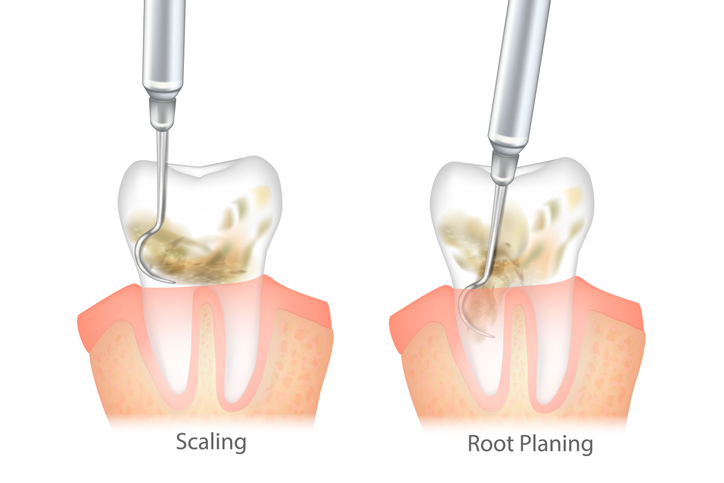 When plaque builds up on teeth, it can harden into tartar and cause several complications for your oral health, even advancing to periodontal disease as it worsens. At Pinnacle Center – Dental Implants & Periodontics, we recommend a scaling and root planing procedure for many cases of chronic periodontal disease, allowing our professional team to restore your smile in all its glory. This procedure is an effective way to manage periodontal disease by providing a deep cleaning to your teeth and gums, preventing the disease from worsening. If you have chronic periodontal disease, it’s our team’s goal to help you regain a healthy mouth, retain your teeth and boost your confidence.
When plaque builds up on teeth, it can harden into tartar and cause several complications for your oral health, even advancing to periodontal disease as it worsens. At Pinnacle Center – Dental Implants & Periodontics, we recommend a scaling and root planing procedure for many cases of chronic periodontal disease, allowing our professional team to restore your smile in all its glory. This procedure is an effective way to manage periodontal disease by providing a deep cleaning to your teeth and gums, preventing the disease from worsening. If you have chronic periodontal disease, it’s our team’s goal to help you regain a healthy mouth, retain your teeth and boost your confidence.
What are Scaling and Root Planing?
The process of removing tartar from the teeth is called scaling and root planing. This is the initial treatment offered for gum disease, designed to clean and smooth the root surface so the gums can heal. This prevents them from receding further and protects your mouth from infection.
Scaling is used to remove plaque and tartar from the teeth. Once this is complete, root planing smooths out the root, creating a healthy and clean root surface that the gums can reattach to. However, because we cannot see all of the plaque and tartar deposits underneath the gum line, this process may not remove all of the buildup and other treatments may be required to remove the remaining deposits. In some cases, surgery may be needed to complete the process and leave the gums healthy.
Why Patients May Need Scaling and Root Planing
The tooth scaling and root planing procedure is often recommended for patients with signs of periodontal disease because it can stop the effects and prevent progression. Chronic periodontal disease is a condition in which plaque builds up and forces the gums to detach from the teeth. When left untreated, periodontal disease can lead to loose teeth, tooth loss or bone and tissue loss.
Chronic periodontal disease causes more than just deep pockets between the gums and teeth. It can also present with symptoms such as red and inflamed gums, bleeding gums, bad breath, changes to the bite or shifting permanent teeth.
If you’ve noticed these symptoms or if you have concerns about chronic periodontal disease, the best thing you can do is schedule an appointment with a periodontist as soon as possible for an examination.
Benefits of Scaling and Root Planing
Scaling and root planing is used as the primary treatment for chronic periodontal disease. It can reduce the pocket gaps between gums and teeth by an average of 0.5 millimeters, thus reducing the risk of loss of bone, tooth and tissue that typically occurs with untreated chronic periodontal disease.
The Scaling and Root Planing Process
Prior to treatment, a diagnosis of chronic periodontal disease is made during a dental check-up or with x-rays to identify bone loss. If necessary, a future appointment will be scheduled for the procedure.
At the appointment, your gums and below the gum line will be cleaned to remove as much tartar as possible, all the way down to the roots. This is typically an outpatient procedure, meaning you will be awake during it, but your provider will numb your mouth using local anesthetic.
When the mouth is numb, your periodontist will use an ultrasonic scaler, a tool that vibrates a metal tip to chip away at tartar from your teeth above the gum line. Using a water spray, the chips of tartar will be washed away and plaque will be flushed from the gum pockets. Any pieces of tartar that were not removed with the ultrasonic scaler will be manually removed with a manual dental scaler and scraping device to leave your teeth free of tartar above the gumline.
Once the scaling is complete, a similar process is completed below the gum line to remove any tartar or plaque from the surface of your roots. A tool is used to expose the roots by pushing aside gum tissue and the same tools are used to smooth out the roots. Your periodontist may also choose to inject antibiotic medication into any developed gum pockets.
Depending on the severity, this may occur over the course of two or three appointments before your mouth has the chance to heal. Once the procedure is completed, you will need to be seen again 4 to 6 weeks later for an examination to determine if it was successful. If all sites are healthy, then you will move into the periodontal maintenance phase, in which you will prevent the buildup of plaque to keep your gums healthy and prevent the progression of periodontal disease. If there are still unhealthy sites, you may need further treatment, which may include osseous surgery in some cases.
Risks of Scaling and Root Planing
Scaling and root planing is a safe treatment option with minimal risks. There is a small risk of infection following the procedure and you may be prescribed an antibiotic or mouthwash to use while your gums heal to prevent it.
It is normal to experience pain, sensitivity and tenderness in the gums while your mouth heals, but these side effects should clear up quickly and many patients find that their mouths feel better as the discomfort subsides.
If you experience worsening pain, a fever or if the area is not healing as expected, it’s important to contact your periodontist immediately to be evaluated for potential infection. Mouth infections should be treated promptly to minimize health effects.
Caring for Your Mouth After Scaling and Root Planing
After scaling and root planing, you will likely notice swelling and tenderness in your gums or tooth sensitivity. Your periodontist will provide you with instructions for your recovery, which often includes using antimicrobial mouthwash, taking over-the-counter pain relievers and eating softer foods.
You may eat after your procedure once the anesthetic has worn off, usually within 1 to 3 hours so you don’t bite or burn your tongue. It’s also generally recommended to use saltwater rinses every few hours to treat tenderness or sensitivity in the gums after the procedure.
Because there is no cure for gum disease since plaque will constantly continue to form, the best way to protect your teeth once they heal is to keep up with daily oral hygiene. Brushing, flossing, using mouthwash and attending regular dental checkups is a crucial part of caring for your mouth after the procedure to prevent the buildup of tartar again and to hopefully minimize the risk of needing to have the procedure completed again in the future.
Contact us to schedule an appointment today!






